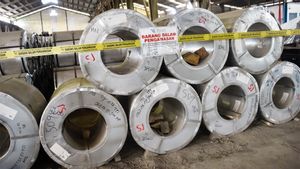JAKARTA - The United States (US) space agency, NASA, is known to always create something related to outer space, such as rockets, spacecraft, and even satellites.
However, it turns out that NASA scientists are also building a technology that can be used for a variety of vehicles on Earth. This was revealed by NASA via its official website quoted by VOI, Tuesday, September 8.
Super Elastic TireInspired by aircraft tires on the Apollo mission to the Moon. NASA has made super elastic tires that don't need air like normal tires. As it turned out, the tires were made of memory alloy material that could travel carrying heavy loads on damaged terrain.
Not only does this tire have superior traction, it can withstand damage such as sharp punctures. This elastic tire is claimed to not leak, so it can save fuel consumption and safety for riders.
- https://voi.id/memori/12594/mobil-tenaga-matahari-pertama-yang-diper]-william-cobb
- https://voi.id/berita/9865/tak-mau-kalah-dari-tesla-nya-elon-musk-hyundai-t Enhanced-production-mobil-listrik
- https://voi.id/berita/6558/mobil-otonom-untuk-antarkan-bahan-pangan-ke-warga-terdampak-covid-19-di-as
Anti Insect GlassWhen driving, we often find surprising things, such as an insect-affixed car windshield, of course this disturbs the driver's view. Likewise in space vehicles, any buildup on these space vehicles can cause significant aerodynamic problems.
Fortunately there are solutions that are inexpensive, easy to implement, and very effective. Simply coat the glass with epoxy coating from NASA. This discovery not only prevents insects from sticking, but also improves the overall efficiency of the vehicle or aircraft used thanks to its improved aerodynamic properties.
Electric Vehicle Battery MonitorNASA argues that as the auto industry continues to shift from fossil fuels to hybrid and electric vehicles, Battery Health Monitoring (BHM) is badly needed for the future.
The space agency based in Washington DC, USA has created BHM technology that ensures optimal vehicle performance, by accurately estimating the vehicle's charge status, remaining battery life, and when the battery needs to be completely replaced.
This technology also protects the battery from dying faster than designed, by providing a warning when the vehicle is not operating within its limits, such as going fast or going on an off-road trip.
Advanced Gear MechanismOur @NASAPersevere Mars rover has an Earth-based twin, and it's already moved into its garage home and passed its first driving test. @NASAJPL teams will run commands on this full-scale engineering version of the rover before they're transmitted to Mars: https://t.co/vi5t0EELYa pic.twitter.com/UBMztL7dw5
- NASA (@NASA) September 5, 2020
To improve car performance, NASA has created special gears that can be used in various mechanical systems in cars. For example, components such as transmissions, power windows, wipers, engines and steering wheels require gears with different designs.
According to NASA, this technology is truly a breakthrough in mechanical architecture. This design can also reduce weight, size and cost while reducing load.
Troubleshooting Sensor in MachineWhile developing new sensors for monitoring turbo jet engines, NASA engineers quickly realized that they had just developed a useful innovation.
NASA invented a compact, efficient, and powerful tool that was easy to install. It can be applied directly to the machine for highly accurate real-time data analysis. Previously, the sensors applied directly to the engine were large and heavy to protect the system from high temperatures.
180 degree Tire Drive ModuleThe Modular Robotic Vehicle (MRV), which was previously an electric lunar rover, is claimed to be very suitable for use on Earth in urban areas or industrial complexes.
Much like the human brain, MRV relies on driver control inputs being converted into electrical signals. The signal is then sent via cables to the engine in the vehicle to control steering and braking.
The MRV itself is driven by four independent wheel modules, which are capable of rotating 180 degrees around the steering axis. This design makes parking easier. By using the MRV, the driver can park parallel.
The English, Chinese, Japanese, Arabic, and French versions are automatically generated by the AI. So there may still be inaccuracies in translating, please always see Indonesian as our main language. (system supported by DigitalSiber.id)













